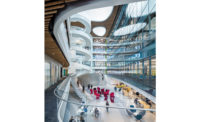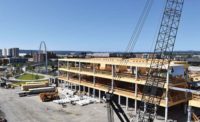A building can promote the well-being of its occupants in a variety of ways—just ask any architect. Some will say it should be free of toxic chemicals. Others might argue that the design should discourage occupants from being too sedentary. Still others will maintain that a building must foster ways for its users to be productive and happy. Now a new certification program called WELL is available. This set of health-centered guidelines could help architects and other professionals define more precisely the relationship between wellness and the built environment.
No doubt there are design teams and clients who question the need for another rating system or an additional plaque to hang on the wall. But advocates maintain that even though LEED provides credits for attributes like daylighting and good indoor air quality, WELL is a complementary system that responds to a distinct set of problems. “It deals with issues that LEED tackles only obliquely,” says Bill Browning, founding partner of research and consulting firm Terrapin Bright Green. “LEED is about the building,” he elaborates, “while WELL is about the experience of the occupants in the building.”
The tool for measuring, certifying, and monitoring the features of the built environment that further human health is the brainchild of Paul Scialla, a former Goldman Sachs partner. In 2007, he founded Delos—a research, consulting, and development company that he describes as a “wellness real-estate” business. He saw opportunity in combining real estate, “the world's largest asset class,” with health and wellness, “its fastest-growing industry,” he explains.
Delos first developed WELL as a proprietary system in collaboration with medical and health professionals. But to further advance its goals, Scialla decided to offer it as a publicly available standard. And, to administer it, he established the International Well Building Institute (IWBI) as a public benefit company, or B-Corp, a type of for-profit entity recognized in many states that includes having a positive impact on society in its mission. Last October, after a multistage peer-review process, the institute released version 1.0 of WELL, which is tailored specifically to offices. Standards for other building types are in the works.
According to IWBI, three pilot projects have so far been certified, and projects totaling more than 10 million square feet, in buildings located throughout the world, are on the path to certification. Although this figure is dwarfed by the number of LEED buildings—almost 60 million square feet were certified in the month of April alone—the WELL tally is impressive, considering that it is still so new.
ROAD TO WELLNESS
In its 216 pages, WELL 1.0 outlines recommended practices, organizing them into seven categories: air, water, nourishment, light, fitness, comfort, and mind. Within each of these are strategies, or in WELL lingo, “features,” which can be applied to a building project or space to promote the health of the human body, including its cardiovascular, immune, and respiratory systems. Some of these strategies are designated as “preconditions,” meaning they are required for certification, while others are voluntary measures, or “optimizations,” that can help a project surpass basic certification and achieve a Gold or Platinum rating.
Sources say that WELL 1.0 catalogues what goes into the making of a healthy environment. The document “teases apart the various aspects of wellness,” rendering its concepts both “accessible and actionable,” says Beth Heider, chief sustainability officer at construction and development company Skanska USA. She served as a peer reviewer, as did Terrapin's Browning.
Many of the 102 features outlined by the standard depend on the space's configuration, its finishes and furnishings, and mechanical systems, and therefore fall directly under the purview of the design and construction team. For example, there are requirements for walls and ceilings to have minimum light reflectance values in order to promote alertness, ultraviolet lamps incorporated into cooling systems to prevent mold growth, and ergonomic furniture. But other strategies, such as those limiting the amount of sugar in drinks available on the premises, housekeeping protocols relying on nontoxic and hypoallergenic products, and policies intended to encourage physical activity, like reimbursement for gym membership, clearly come under the purview of the client or tenant.
Some of the features are ahead of available technology. Aliza Skolnik, a senior associate with consulting engineering firm ESD, cites an optimization that calls for sensors continuously monitoring and displaying noise levels. There is no sensor suited for that purpose yet on the market, explains Skolnik, who is among the first group of provisional WELL APs, or accredited professionals (she will be eligible for full AP status after passing an exam to be offered for the first time this fall).
Designers from Mark Horton Architecture and Leddy Maytum Stacy Architects (LMS) encountered a similar problem when they renovated a floor in a 1920s office building in San Francisco's financial district. The client was Fahr LLC, which oversees several organizations owned and managed by environmen- talists Tom Steyer and Kat Taylor. In addition to WELL, the architects for the recently completed project are seeking certification under the Living Building Challenge (LBC)—a standard whose stringent requirements include a prohibition against using materials that contain any one of 22 chemicals on a so-called “red list.” The dual certification goal complicated furniture selection for the offices, especially since a compressed schedule, with less than two months for design, allowed little time for the vetting of materials. “If 12 chairs met the red list, WELL's ergonomic requirements eliminated 11 of them,” says Adam Franch, project architect from LMS. Horton believes that programs like WELL and LBC will provide manufacturers with an incentive to broaden the range of compliant products. “All of this momentum will eventually change the market,” he predicts.
THE PRICE OF HEALTH
The certification process, which includes an on-site assessment for the testing of air, water, and lighting quality, will be managed by the Green Business Certification Institute (GBCI)—the organization (formerly the Green Building Certification Institute) that is also responsible for LEED certification. Fees for registration and commissioning vary depending on a project's size and type, but for a tenant improvement project smaller than 50,000 square feet, the total would be $8,300. IWBI charges additional fees for the audit, which begin at $4,000.
The cost of actual compliance is a bit less clear-cut. Michelle Moore, an IWBI strategic adviser, points out that with only three certified projects so far there isn't enough data for a comprehensive analysis. However, she expects low incremental construction costs, especially for those projects also targeting LEED. “Project teams that have figured out integrated design know that sustainability is about different decisions, not necessarily about more expensive ones.” She recommends putting the two rating systems' checklists side by side to identify areas of overlap and pinpoint which credits or features entail additional investment. To aid this process, WELL 1.0 includes appendices that compare it with both LEED and the Living Building Challenge.
Onno Zwaneveld, an executive at real-estate services and investment company CBRE, says WELL features for his company's new Gensler-designed office on two floors of a 26-story building in downtown Los Angeles added 1.7 percent to the construction budget over the cost of its LEED Gold certification. The space, which received its WELL certification in November 2013, includes advanced air filtration and water purification, lighting intended to minimize the disruption of the body's circadian system, and ergonomic furniture such as stand-up desks.
Similarly, Josh Gould, CEO of RNL, the architect for a 229-unit condo complex in Denver, anticipates its premium for WELL compliance to be “just a few percentage points” when compared to a more conventional apartment building. Slated for completion in the fall of 2017, the structure will have a number of features intended to encourage physical activity, including a 12-story tower with a glass-enclosed stair. The architects hope that the views the stair will provide of the surroundings will entice residents to use them rather than the elevator. Gould expects WELL certification to enlarge the pool of prospective buyers.
It goes without saying that it is easier to incorporate WELL if the goal is set early in the planning and design process. But it is possible to achieve certification even if that decision is made after the completion of construction. That's what the Phipps Conservatory and Botanical Gardens in Pittsburgh did with its Center for Sustainable Landscapes (CSL), a 24,000-square-foot administrative building executed by local architecture firm The Design Alliance. Completed in late 2012, the structure is LEED Platinum and Living Building Challenge–certified. It received its WELL Platinum certification in October.
In order to meet WELL standards, Phipps made only minimal changes to the building, which had been designed with many health-promoting aspects including ample daylight and a strong connection to the outdoors. Phipps added more ventilation to a copier room and swapped in ergonomic furniture. It also implemented a few changes to operating procedures and policies. These involved enhancing its already green cleaning practices, supplying break rooms with fresh fruit, and making Fitbits available to employees.
GREATER GOOD
Fans of the new standard hope it will advance the discussion of health and architecture into the public realm. However, some worry that, for the moment at least, an environment that promotes wellness is perceived as a luxury. “We need to make sure we divorce healthy buildings from a level of amenity,” says Claire Maxfield, director of the San Francisco office of Atelier Ten, an environmental design consultancy that was a peer reviewer of WELL's lighting sections. “I'm sure even IWBI would say so,” she adds.
And in fact, Scialla maintains that he is absolutely dedicated to a standard that can be broadly employed. He says this goal will be furthered by IWBI's B-Corp status, which includes a commitment to contribute 51 percent of net profits from certification fees to philanthropic entities and investment that focuses on health and wellness. Among the rating system's many current pilot projects is the William Jefferson Clinton Children's Center—an orphanage in Port-au-Prince, Haiti, which is a collaboration between the U.S. Green Building Council and HOK. Details regarding another pilot project—an affordable-housing complex in New York—are expected to be announced soon. WELL isn't just for luxury apartments or class-A offices, says Scialla: “It is appropriate for any project type at every cost level.”
|
Continuing Education
 To earn one AIA learning unit (LU), including one hour of health, safety, and welfare (HSW) credit, read “The Picture of Health,” review the WELL Building Standard Executive Summary, and complete the online test. Upon passing the test, you will receive a certificate of completion, and your credit will be automatically reported to the AIA. Additional information regarding credit reporting and continuing-education requirements can be found online at continuingeducation.bnpmedia.com. To earn one AIA learning unit (LU), including one hour of health, safety, and welfare (HSW) credit, read “The Picture of Health,” review the WELL Building Standard Executive Summary, and complete the online test. Upon passing the test, you will receive a certificate of completion, and your credit will be automatically reported to the AIA. Additional information regarding credit reporting and continuing-education requirements can be found online at continuingeducation.bnpmedia.com.
Learning Objectives
1 Explain the goals of WELL. 2 Outline the structure of WELL 1.0 and explain how it helps define the relationship between human health and the built environment. 3 Discuss how WELL differs from more established green building-rating systems such as LEED. 4 Discuss the challenges that the certification process poses for design teams. AIA/CES Course #K1506A
For CEU credit, Read “The Picture of Health” and take the Quiz at continuingeducation.bnpmedia.com, or use our architectural record continuing-education app, available in the itunes store.
|









